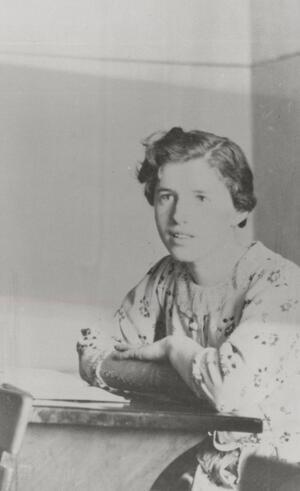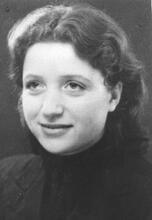Hildegard Löwy
Born in 1922, Hildegard Löwy was the youngest member of the Baum Gruppe, a mainly Jewish resistance group against the Nazi regime in Berlin. She belonged to the sub-group of Heinz Joachim, which operated jointly with Herbert Baum’s group. She had firm Zionist and pacifist principles and believed communism was the best way for Jews to obtain equal rights. She had hoped to emigrate to Palestine but was unable to do so due to her family circumstances and her disability. Löwy was surprised by her arrest in April 1942 and tried to escape from prison, but she was ultimately convicted of organized Communist treason and was executed in a Berlin prison.
Early Life
Born in 1922, Hildegard Löwy was the youngest member of the Baum Gruppe, a mainly Jewish resistance group against the Nazi regime in Berlin. She belonged to the sub-group of Heinz Joachim, which operated jointly with Herbert Baum’s group.
In the spring of 1940 Hilde Löwy completed her final examinations at the last remaining Jewish high school in Berlin, on Wilsnacker Strasse. The only female in the graduating class of eleven, she was an outstanding student. She was a member of the Zionist-Socialist youth movement Ha-Shomer ha-Za’ir from the mid-1930s and intended to move to Palestine. However, all her efforts at emigration failed because she had only one arm. Despite the intervention of Recha Freier, the “mother” of Youth Lit. "ascent." A "calling up" to the Torah during its reading in the synagogue.Aliyah, Löwy did not pass the medical examination required for entry into Palestine. Another reason she could not go to Palestine was that her father, who had fought in World War I and was a German patriot, refused to act with regard to his family’s emigration until it was too late.
The dwindling financial resources of Hildegard’s family did not allow her to emigrate anywhere. Thus, her hopes of studying medicine at the Hebrew University of Jerusalem also came to naught. An account of her character from the time of her membership in Ha-Shomer ha-Za’ir describes her as mature for her age, talented and highly intelligent.
Arrest
When Hilde was arrested at 10 a.m. on April 15, 1942, while in the company of her mother, the Gestapo showed her a photograph of her friend and lover, Georg Israel (1921–1944), alongside a photograph of herself. They had met at the beginning of 1939 when their school closed after the November 1938 pogrom, leading them to transfer to the last Jewish high school operating in Berlin. They lived together until Hilde’s arrest, which, like her indictment, came as a complete surprise to Georg. She had told him nothing about the group or her political activity, which indicates the seriousness with which she related to her activities. Despite the love between them, the rules of conspiracy were stronger.
Georg Israel, who was a first-degree mischling according to the racial laws, did not survive. Working in public transportation and in loading sacks of candy, he was caught with a few candies he had taken from one of the sacks. In 1943, he was sentenced to one year in prison. After serving his sentence, he was incarcerated in a camp near Berlin, where he perished in an epidemic.
Beliefs and Imprisonment
Although Hildegard belonged to a group with a clear Communist orientation, she would not give up her Zionist beliefs or pacifist stand. However, she believed that the victory of Communism would provide a better opportunity for Jews to obtain equal rights. During her pre-trial interrogation, she spoke openly of her beliefs, her membership in Ha-Shomer ha-Za’ir, and her aspiration to implement the ideals of the movement. She also declared: “My goal is to revive this forbidden youth movement. I am convinced that Bolshevism is the most important element in the struggle against Hitlerism.”
Despite her physical disability, she tried to escape from prison a week before her trial. Braiding her sheets into a rope, she managed to climb out of the window of her cell but was caught before she reached the ground.
The trials of Rotholz and fellow members of her group, together with her own, took place in the Second People’s Court on December 10, 1942. In the course of that one day nine death sentences were meted out for organized Communist treason— against Heinz Rotholz (1922–1943), Heinz Birnbaum (1920–1943), Hella Hirsch (1921–1943), Hanni Meyer (1921–1943), Marianne Joachim (1922–1943), Lothar Salinger (1920–1943), Helmut Neumann (1922–1943), Hildegard Löwy and Siegbert Rotholz (1922–1943). They were executed in Berlin-Plötzensee on March 4, 1943.
Brothers, Eric. Berlin Ghetto: Herbert Baum and the Anti-Fascist Resistance. Stroud, England: 2012.
Eschwege, Helmut. “Resistance of German Jews against the Nazi Regime.” LBI Yearbook 15 (1970): 170, 177–179.
Kreutzer, Michael. In Juden im Widerstand: drei Gruppen zwischen ueberlebenskampf und Politischer Aktion, Berlin 1939–1945. Berlin: 1984, 114–117, 152.
Kwiet, Konrad, and Helmut Eschwege. Selbstbehauptung und Widerstand: Deutsche Juden im Kampf um Existenz und Menschenwuerde 1933–1945. Hamburg: 1984, 117–119, 130, 132–133.
Scheer, Regina. Im Schatten der Sterne: Eine jüdische Widerstandsgruppe. Berlin: 2004.




